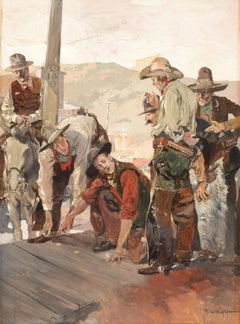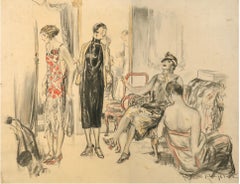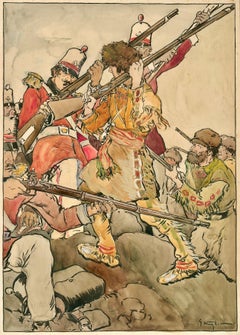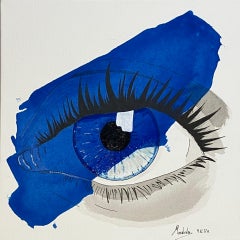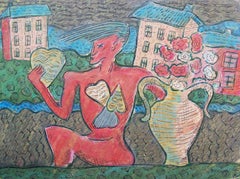George Hand Wright Art
to
4
4
3
2
1
Seats of the Haughty, Munsey's Magazine Illustration
By George Hand Wright
Located in Fort Washington, PA
Medium: Gouache on Board
Signature: Signed Lower Right
Seats of the Haughty, Munsey's Magazine illustration, December 1906
Literature: This illustration appeared in O. Henry's shor...
Category
Early 1900s George Hand Wright Art
Materials
Board, Gouache
Young Woman Tries on Gown
By George Hand Wright
Located in Fort Washington, PA
Signed Lower Right by Artist
Magazine story illustration: “Mr. and Mrs. Fixit”, author: Ring Lardner, Liberty Magazine; publisher: (Liberty Weekly, Inc.), Vol. 2, no 1, May 9, 1925.
Category
1920s George Hand Wright Art
Materials
Watercolor, Charcoal
British Soldiers in Combat
By George Hand Wright
Located in Fort Washington, PA
Medium: Ink and Gouache
Signature: Signed Lower Right
Probably a magazine cover for a Munsey’s pulp, ca. 1905.
Category
Early 1900s George Hand Wright Art
Materials
Gouache, Ink
Figure in the Forest
By George Hand Wright
Located in Fort Washington, PA
Medium: Watercolor on Board
Dimensions: 23.50" x 15.00"
Signature: Signed Lower Right
Category
20th Century George Hand Wright Art
Materials
Watercolor, Board
Related Items
Te ves?
Located in MADRID, ES
Las emociones negativas retienen toda la atención, impidiendo atender otra cosa.
Category
2010s George Hand Wright Art
Materials
Ink, Gouache, Pen
Red Figure Holding a Heart - Irish Art
Located in London, GB
This original work is hand signed in ink by the artist at the lower right corner "Rakoczi".
Condition: Very good condition. A few cuts in the edges of the board (possibly from forme...
Category
20th Century George Hand Wright Art
Materials
Ink, Board, Gouache, Oil
Pounds and Shillings, 20th Century Female Artist, Signed and Framed Painting
By Joan Fairfax Whiteside ARRC FMAA
Located in London, GB
Gouache on card, signed lower right
Image size: 16 1/2 x 11 1/2 inches (42 x 29.25 cm)
Contemporary style frame
Joan Fairfax Whiteside
Joan Fairfax Whiteside was a prodigious arti...
Category
Mid-20th Century George Hand Wright Art
Materials
Gouache, Cardboard
The Great Flood of Paris - Impressionist Landscape Gouache Painting - Luigi Loir
By Luigi Loir
Located in Marlow, Buckinghamshire
Signed gouache on board impressionist landscape by French painter Luigi Loir. This work depicts the famous flood of Paris in 1910 when the Seine broke its banks in the largest flooding the city had seen in a 100 years. Loir likely painted this work "en plein air" as he encountered this rare natural occurrence.
Signature:
Signed lower left
Dimensions:
Framed: 13"x19"
Unframed: 5"x11"
Provenance:
Private French collection
He first exhibited at the Paris Salon in 1865 with a Landscape at Villiers-sur-Seine which brought him a certain amount of recognition. He was a regular exhibitor at the Salon des Artistes Français. Obtaining a third-place medal in 1879, and a second-place medal and a gold medal in 1889 at the Exposition Universelle in Paris. He was decorated with the Légion d'Honneur in 1898.
Born in Austria to French parents who served the exiled French Bourbon royal family, Luigi Aloys-François-Joseph Loir moved with his family and the Bourbons to the Duchy of Parma in 1847. In 1860 his family returned to Paris following the expulsion of the Bourbons from Parma. But Luigi remained in the city, having enrolled, at the young age of eight, at the Accademia de Belle Arti. He eventually rejoined his family in Paris in 1863. There he studied with the decorative painter and set designer Jean Pastelot, making his Salon debut in 1865. Loir painted mainly views of Paris, in all seasons and at different times of the day or night.
Loir was the Paris painter...
Category
Early 20th Century Impressionist George Hand Wright Art
Materials
Gouache, Board
Place de la Bastille - Impressionist Snowy Cityscape by Eugene Galien-Laloue
By Eugene Galien-Laloue
Located in Marlow, Buckinghamshire
Signed impressionist gouache on board circa 1890 by sought after French painter Eugene Galien-Laloue. The piece depicts a depicting a bustling city scene at the Place de Bastille in ...
Category
1890s Impressionist George Hand Wright Art
Materials
Board, Gouache
Mid Century Sgraffito, Saltimbanque and the Card Player, Circle of Picasso.
Located in Cotignac, FR
Mid 20th Century sgraffito work on plaster by Jean Pierre de Cayeux. The work is signed and dated on the skirt of the card player, bottom right, and on the stretcher of the chair, bo...
Category
Mid-20th Century Modern George Hand Wright Art
Materials
Enamel
H 16.93 in W 12.41 in D 0.6 in
Arlecchino in blu e grigio (Harlequin in Blue and Gray)
By Duilio Barnabe
Located in Chicago, IL
This work is signed by Barnabè in the lower right. Harlequins were one of Barnabè's favorite subjects, reminders of the costumed revellers at the famous Carnival of Venice celebrated...
Category
Mid-20th Century Modern George Hand Wright Art
Materials
Charcoal, Gouache
The Pleiades-Taygete - nude, female, figurative, charcoal and ink on canvas
By Richard Tosczak
Located in Bloomfield, ON
Richard Tosczak creates life size paintings and sketches of his models which he then recreates in bronze. This large scale canvas reflects speed, gesture and the effect of capturing ...
Category
2010s Contemporary George Hand Wright Art
Materials
Archival Ink, Watercolor, Canvas, Charcoal, Acrylic Polymer
Old City Jerusalem City Walls landscape Scene Painting, Judaica
By Jossi Stern
Located in Surfside, FL
Vibrant Gouache and watercolor painting by Israeli master JOSSI STERN. on paper mounted to board. 31x34.75, 23.5x27.5 without frame.
Hungary, b. 1923, d. 1992
Jossi (Yossi) Stern, son of David and Katerina, was born in the Bakon Hills of Hungary, in 1923. He was already drawing when at the age of ten he moved with his family from the Bakon Hill region to the considerably more cosmopolitan Budapest.
Recognizing the looming threat of Hitler and the pending Nazi invasion of Hungary, in 1940, at the age of seventeen, the young artist made his way to Palestine aboard the Sakaria, an old ship heavily crowded with 2,300 other refugees. Before reaching the shores of Palestine, then under the British Mandate, the British Navy intercepted the ship and declared Stern and all those aboard illegal immigrants. Stern was sent to a prison camp where he remained incarcerated by the British for six months.
In 1943, having spent a few years doing agricultural work, Stern was encouraged by close friends who recognized his artistic talent to enroll in the prestigious Bezalel School of the Arts in Jerusalem. An outstanding student, he eventually became a highly respected teacher of Graphic Arts at Bezalel.
Stern is recognized in Israel as having been one of the country's premier artists...
Category
20th Century Modern George Hand Wright Art
Materials
Watercolor, Gouache, Illustration Board
Rare Modernist Hungarian Rabbi Pastel Drawing Gouache Painting Judaica Art Deco
By Hugó Scheiber
Located in Surfside, FL
Rabbi in the synagogue at prayer wearing tallit and tefillin.
Hugó Scheiber (born 29 September 1873 in Budapest – died there 7 March 1950) was a Hungarian modernist painter.
Hugo Scheiber was brought from Budapest to Vienna at the age of eight where his father worked as a sign painter for the Prater Theater. At fifteen, he returned with his family to Budapest and began working during the day to help support them and attending painting classes at the School of Design in the evening, where Henrik Papp was one of his teachers. He completed his studies in 1900. His work was at first in a post-Impressionistic style but from 1910 onward showed his increasing interest in German Expressionism and Futurism. This made it of little interest to the conservative Hungarian art establishment.
However, in 1915 he met the great Italian avant-gardist Filippo Tommaso Marinetti and the two painters became close friends. Marinetti invited him to join the Futurist Movement. The uniquely modernist style that he developed was, however, closer to German Expressionism than to Futurism and eventually drifted toward an international art deco manner similar to Erté's. In 1919, he and his friend Béla Kádar held an exhibition at the Hevesy Salon in Vienna. It was a great success and at last caused the Budapest Art Museum to acquire some of Scheiber's drawings. Encouraged, Scheiber came back to live in Vienna in 1920.
A turning point in Scheiber's career came a year later, when Herwarth Walden, founder of Germany's leading avant-garde periodical, Der Sturm, and of the Sturm Gallery in Berlin, became interested in Scheiber's work. Scheiber moved to Berlin in 1922, and his paintings soon appeared regularly in Walden's magazine and elsewhere. Exhibitions of his work followed in London, Rome, La Paz, and New York.
Scheiber's move to Germany coincided with a significant exodus of Hungarian artists to Berlin, including Laszlo Moholy-Nagy and Sandor Bortnyik. There had been a major split in ideology among the Hungarian avant-garde. The Constructivist and leader of the Hungarian avantgarde, Lajos Kassák (painted by Hugó Scheiber in 1930) believed that art should relate to all the needs of contemporary humankind. Thus he refused to compromise the purity of his style to reflect the demands of either the ruling class or socialists and communists. The other camp believed that an artist should be a figurehead for social and political change.
The fall out and factions that resulted from this politicisation resulted in most of the Hungarian avant gardists leaving Vienna for Berlin. Hungarian émigrés made up one of the largest minority groups in the German capital and the influx of their painters had a significant effect on Hungarian and international art. Another turning point of Scheiber's career came in 1926, with the New York exhibition of the Société Anonyme, organized by Katherine Dreier. Scheiber and other important avant garde artists from more than twenty-three countries were represented. In 1933, Scheiber was invited by Marinetti to participate in the great meeting of the Futurists held in Rome in late April 1933, Mostra Nazionale d’Arte Futurista where he was received with great enthusiasm. Gradually, the Hungarian artists began to return home, particularly with the rise of Nazism in Germany. Kádar went back from Berlin in about 1932 and Scheiber followed in 1934.
He was then at the peak of his powers and had a special flair in depicting café and cabaret life in vivid colors, sturdily abstracted forms and spontaneous brush strokes. Scheiber depicted cosmopolitan modern life using stylized shapes and expressive colors. His preferred subjects were cabaret and street scenes, jazz musicians, flappers, and a series of self-portraits (usually with a cigar). his principal media being gouache and oil. He was a member of the prestigious New Society of Artists (KUT—Képzőművészek Új Társasága)and seems to have weathered Hungary's post–World War II transition to state-communism without difficulty. He continued to be well regarded, eventually even receiving the posthumous honor of having one of his images used for a Russian Soviet postage stamp (see image above). Hugó Scheiber died in Budapest in 1950.
Paintings by Hugó Scheiber form part of permanent museum collections in Budapest (Hungarian National Museum), Pecs (Jannus Pannonius Museum), Vienna, New York, Bern and elsewhere. His work has also been shown in many important exhibitions, including:
"The Nell Walden Collection," Kunsthaus Zürich (1945)
"Collection of the Société Anonyme," Yale University Art Gallery, New Haven, Connecticut (1950)
"Hugó Scheiber: A Commemorative Exhibition," Hungarian National Museum, Budapest (1964)
"Ungarische Avantgarde," Galleria del Levante, Munich (1971)
"Paris-Berlin 1900-1930," Centre Georges Pompidou, Paris (1978)
"L’Art en Hongrie, 1905-1920," Musée d’Art et l’Industrie, Saint-Etienne (1980)
"Ungarische Avantgarde in der Weimarer Republik," Marburg (1986)
"Modernizmus," Eresz & Maklary Gallery, Budapest (2006)
"Hugó Scheiber & Béla Kádár," Galerie le Minotaure, Paris and Tel Aviv (2007)
Hugó Scheiber's paintings continue to be regularly sold at Sotheby's, Christie's, Gillen's Arts (London), Papillon Gallery (Los Angeles) and other auction houses.
He was included in the exhibition The Art Of Modern Hungary 1931 and other exhibitions along with Vilmos Novak Aba, Count Julius Batthyany, Pal Bor, Bela Buky, Denes Csanky, Istvan Csok, Bela Czobel, Peter Di Gabor, Bela Ivanyi Grunwald, Baron Ferenc Hatvany, Lipot Herman, Odon Marffy, C. Pal Molnar...
Category
Early 20th Century Modern George Hand Wright Art
Materials
Paper, Charcoal, Pastel, Watercolor, Gouache
Nude Woman on Striped Chair #2 in Charcoal and Gouache on Paper
Located in Soquel, CA
Nude Woman on Striped Chair #2 in Charcoal and Gouache on Paper
Black and white painting of a woman by acclaimed bluegrass musician Katherine "Kathy" Kallick (American, b. 1952). Th...
Category
1970s Contemporary George Hand Wright Art
Materials
Charcoal, Gouache, Paper
H 19 in W 14 in D 0.02 in
Figurative Nude Study - Watercolor and Charcoal on Paper
Located in Soquel, CA
Figurative Nude Study - Watercolor and Charcoal on Paper
Watercolor and charcoal painting of a nude reclining woman by acclaimed bluegrass musician and San Francisco artist Katherin...
Category
1970s Abstract Expressionist George Hand Wright Art
Materials
Charcoal, Paper, Watercolor
H 28.5 in W 22.5 in D 1 in
George Hand Wright art for sale on 1stDibs.
Find a wide variety of authentic George Hand Wright art available for sale on 1stDibs. You can also browse by medium to find art by George Hand Wright in paint, watercolor, board and more. Not every interior allows for large George Hand Wright art, so small editions measuring 15 inches across are available. Customers who are interested in this artist might also find the work of Walter G. Ratterman, George G. Adomeit, and Morgan Weistling. George Hand Wright art prices can differ depending upon medium, time period and other attributes. On 1stDibs, the price for these items starts at $900 and tops out at $7,900, while the average work can sell for $5,700.
